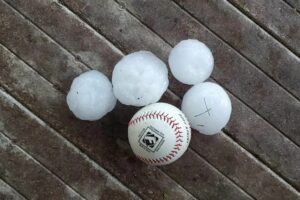Hail storms can wreak havoc on your property, causing extensive damage to buildings, vehicles, and outdoor structures. As a policyholder, it’s important to take proactive measures to protect your property against the destructive force of hail. We’ve compiled a list of actionable steps and strategies to protect your property during a hail storm, aiming to ensure the safety of your investment and minimize potential damage.
Hail Storm Defense Guide
Understand Hail Damage
Hailstones vary in size, ranging from small pellets to large chunks that can cause significant damage upon impact. Common forms of hail damage include dented or cracked roofing, shattered windows, and structural harm to exterior surfaces.
Evaluate Your Roof
The roof is the first line of defense against hail. Conduct a thorough inspection of your roofing system to identify any existing vulnerabilities or areas of concern. Look for loose or missing shingles, deteriorated flashing, and signs of previous hail damage. Reinforcing weak spots and ensuring proper installation can enhance your roof’s resilience during a hail storm. To have your property inspected by a licensed professional, connect with Premier Claims today.
Invest in Impact-Resistant Roofing Materials
Consider upgrading to impact-resistant roofing materials designed to withstand hail damage. Options such as asphalt shingles with Class 4 ratings, metal roofing, or synthetic slate offer superior durability and can protect your property during a hail storm. Consult with roofing professionals to determine the most suitable materials for your property.
Reinforce Windows and Doors
Windows and doors are susceptible to hail damage, especially during severe storms. Install impact-resistant windows and doors equipped with laminated or tempered glass to minimize the risk of breakage. Additionally, consider installing protective shutters or storm panels for an extra layer of defense during hail storms.
Secure Outdoor Items
Outdoor furniture, equipment, and decorative elements are vulnerable to hail damage. Secure or relocate these items indoors or to a sheltered area before a hail storm hits. Trim overhanging branches and remove debris that could become projectiles in high winds, posing a threat to your property.
Maintain Gutters & Downspouts
Proper drainage is essential for diverting water away from your property during a hail storm. Keep gutters and downspouts clear of debris to prevent clogging and potential water damage. Consider installing gutter guards to help minimize the accumulation of debris and maintain efficient water flow.
Consider Impact-Resistant Siding
If your property has siding, consider upgrading to impact-resistant materials such as fiber cement, vinyl, or metal siding. These options offer increased resistance to hail damage and can help protect your property’s exterior from dents, cracks, and other forms of structural harm.
Policy Review
Review your insurance policy to understand the extent of coverage for hail damage. It’s important that your policy provides adequate protection for your property and consider additional coverage options if necessary. Document the condition of your property before and after a hail storm to facilitate the claims process. To have your policy reviewed by our team of licensed professionals, submit your policy here: https://premier-claims.com/policy-review/
Protecting your property during a hail storm requires careful planning and proactive measures. By understanding the potential risks, investing in resilient materials, and implementing preventive strategies, you can minimize the impact of hail damage on your property. Stay informed, stay prepared, and take proactive steps to protect your property against this year’s hail storms.



